Maria Montessori a Theosophist?

Most of us care about education and realize it is an important key to success in life. Education gives us knowledge, skills, and ethics to help us progress on our life's journey. Many of us were educated in public school systems and a few privileged had private education. Whether private schools or public, without education we cannot make sound judgments and without knowledge we cannot have good opinions . Education gives us knowledge through the process of gaining information about the surrounding world. And education need never end if we have a quest for truth.
My upbringing was in public schools and frankly, I grew disappointed with the system when I hit seventh grade, which in the U.S. is about twelve years old. I found most school subjects uninteresting. When I went to college I had a different viewpoint because I felt I had choices in what I wanted to learn and I did very well. When I heard about the Montessori method while a member of the Summit Lighthouse (aka Church Universal and Triumphant) I wanted that method for my children. Maria Montessori ((1870-1952)) developed the system in the early part of the twentieth century. The main premise of the method is not to teach the students but to give them tools to develop and bring out their own innate knowledge. Students progress at their own pace and there are no set rules on how long it takes them to learn a lesson or what they should learn.
Some of my children attended the church Montessori school but for too short of a time to notice any benefits of the system. Madame Caspari, a member of the church, was trained by Montessori and worked side-by-side with her while they both were confined to India for four years when World War II broke out. Madam Caspari moved to America where she found the Summit Lighthouse and then began training Montessori teachers for the Montessori school they started..
Recently, a friend who trained in the Montessori method while in the Summit Lighthouse and had a career as a teacher in early childhood education, sent me some information about Maria Montessori's beliefs and association with the Theosophical Society founded by Helena Blavatsky. This was the first time I heard she had become a member of the Society. While that information possesses no problems for Summit students who accepted Theosophy unreservedly, for those who have come to realize the underlying darkness connected with the Ascended Masters, New Age, and Blavatsky's Theosophy it is something to consider whether the system is actually beneficial for children or, as some believe, detrimental to children based on a distorted view of our relationship with God and purpose in life.
Different biographies on Montessori's life give varied dates and information such as the date of her move to Rome, when and where she received her education and degrees, and her work history, as well as the reason for her not marrying and her choice to give up her son. Thus, I cannot vouch for the accuracy here, unfortunately, but I am providing what appears to be the most accurate accounts.
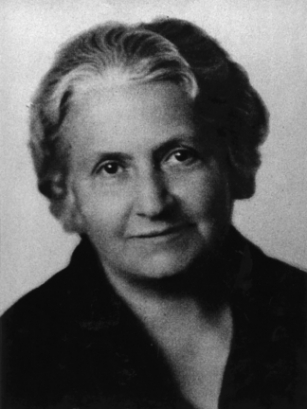 Maria Montessori was born in Italy in 1870. When Maria was twelve years old when her family moved to Rome where she received an excellent education. She was a quick learner and at an early age entered a boys' technical school in order to become an engineer. After seven years she transferred to medicine and at age 26 she became Italy's first female physician. She studied physical anthropology and worked for a time as an instructor in hygiene and anthropology. In 1899 she was appointed director of the State Orthophrenic School in Rome, whose function was to care for the "hopelessly deficient" and "mentally disturbed" children of the city. It was there that she had the opportunity to implement and refine materials for the children and where she enjoyed tremendous success in teaching the children and applying her unique methods.
Maria Montessori was born in Italy in 1870. When Maria was twelve years old when her family moved to Rome where she received an excellent education. She was a quick learner and at an early age entered a boys' technical school in order to become an engineer. After seven years she transferred to medicine and at age 26 she became Italy's first female physician. She studied physical anthropology and worked for a time as an instructor in hygiene and anthropology. In 1899 she was appointed director of the State Orthophrenic School in Rome, whose function was to care for the "hopelessly deficient" and "mentally disturbed" children of the city. It was there that she had the opportunity to implement and refine materials for the children and where she enjoyed tremendous success in teaching the children and applying her unique methods.
Montessori had given birth to a son through a relationship with a colleague, Dr. Guiseppi Montesano in 1998. They both agreed not to marry although why they did not marry is very unclear. Apparently, his family and Maria herself were opposed to marriage. Maria never married although Guiseppi married soon after their relationship ended. Presuming that upon marrying she would be expected to give up her career due to the stigma and expectations of society and an unwed mother, Maria chose to continue with her work and placed her son, Mario, in foster care. Over the next decade, she would see the child occasionally but she never indicated to him that she was his mother until he was about fifteen, and then they became lifelong companions.
Maria had strong feminist beliefs from an early age partly due to her experiences in the pursuit of her education and being subjected to gender inequalities and discrimination against women. Throughout her life, she was a frequent participant in international feminist events and promoting the altering of the relationship of women in the family. As a woman of her time, and as an Italian, she was – of course – a Roman Catholic. But her faith was the faith of a scientist and a scholar, skeptical and refined and heavily influenced by revolution and theosophy. The same year Maria's son was born she officially joined the Theosophical Society. Seven years later she started her first new school.
In 1901 Montessori left the Orthophrenic School supposedly because Dr. Montesano married and the difficulty in having to work so close with him. She enrolled in the university taking courses studying theoretical and moral philosophy, and other private pursuits studying anthropology and educational philosophy. At the same time, she began to consider adapting her methods of educating mentally disabled children to mainstream education. In 1904 she was made a Professor at the University of Rome where for four years she occupied the Chair of Anthropology. The opportunity to do so happened in 1906 when she was invited to oversee the care and education of a group of children of working parents in a new apartment building for low-income families. It was then that she opened up her first school called Casa dei Bambini, or Children's House, in1907, enrolling 50 to 60 children between the ages of two to seven. Her successes led to the opening of other Montessori schools, and for the next 40 years she traveled throughout Europe, India, and the United States lecturing, writing, and establishing teacher-training programs.
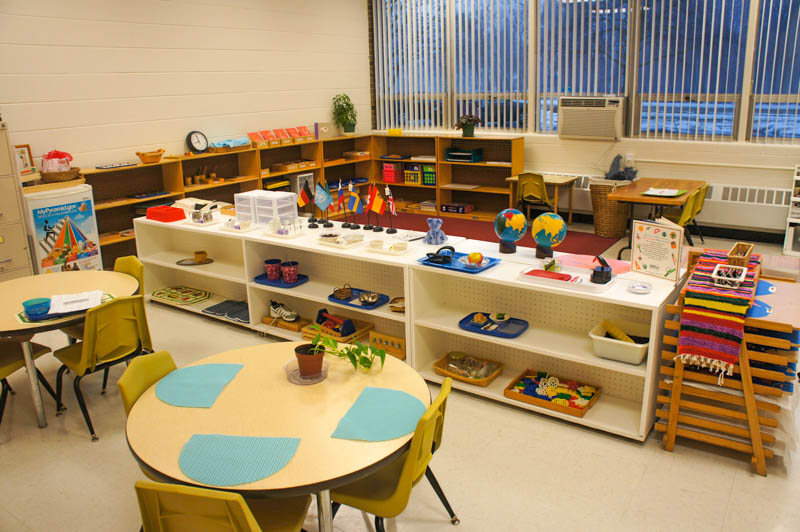
So what makes this method different from traditional teaching methods? The Montessori method of teaching is based on self-directed activity, hands-on learning, and collaborative play. It’s split into three groups: infant/toddler (ages 0 to 3), primary (ages 3 to 6), and elementary (ages 6 to 12). There are usually up to 30 children and two teachers in each classroom. Children learn by working with specially designed materials. Children can learn at their own pace and pursue what they are interested in. They aren’t beholden to any sort of classroom structure, and they’re taught skills that foster independence, such as how to prepare their own food. The picture above depicts a typical classroom setting, neat and clean, with shelves for the tools and everything child size.
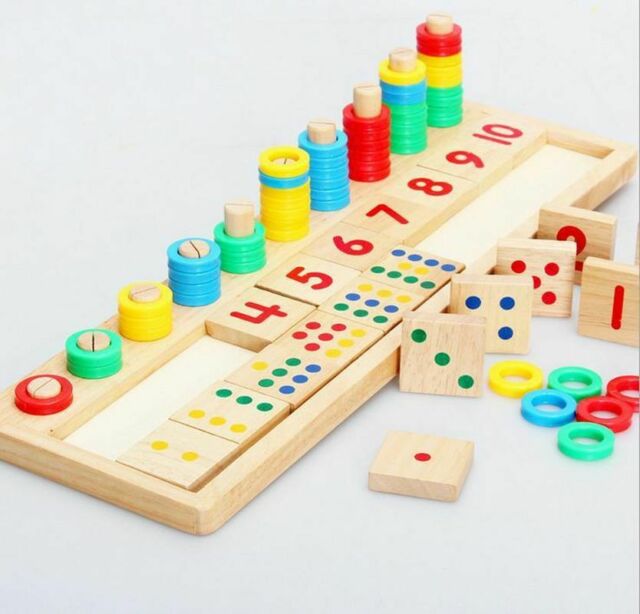 However, the core of a Montessori school is its particular materials; the picture to the left shows a typical math work designed for children from kindergarten (or late preschool) to middle elementary. A Montessori classroom without its specific materials is, in fact, not much of a Montessori environment at all; most of the classwork time is devoted to students (by themselves, in groups, or with the aid of a teacher) manipulating work, proceeding from a set beginning to a set end. Montessori subscribed to constructivism, a theory of education that says students do better if we let them piece together how the world works by moving through it themselves than if we deliver knowledge top-down.
However, the core of a Montessori school is its particular materials; the picture to the left shows a typical math work designed for children from kindergarten (or late preschool) to middle elementary. A Montessori classroom without its specific materials is, in fact, not much of a Montessori environment at all; most of the classwork time is devoted to students (by themselves, in groups, or with the aid of a teacher) manipulating work, proceeding from a set beginning to a set end. Montessori subscribed to constructivism, a theory of education that says students do better if we let them piece together how the world works by moving through it themselves than if we deliver knowledge top-down.
Some who believe there are flaws in Montessori's methods, believe her involvement in theosophy helped form her education methods as well as her understanding of God and religion. Others who support her teaching method promote her as being a devout Catholic. But you cannot be a devout Catholic and a Theosophist as they are incapable. After Maria placed her son in foster care she began a series of lectures around Italy in 1899 amplifying her vision of the “New Woman.” She contended, “the woman of the future will have equal rights as well as equal duties. She will have a new self-awareness and will find her true strength in an emancipated maternity. Family life as we know it may change, but it is absurd to think the feminism will destroy maternal feelings. The new woman will marry and have children out of choice, not because matrimony and maternity are imposed on her.”
Montessori's idea of feminism is not congruent with her supposed Catholic faith. According to Catholic teachings, it is clear that children are the fruit of marriage, as well as its primary end and Maria rejected the moral obligation of both husbands and wives to carry out God's command in Genesis to be fertile and multiply.
It was in 1907, the same year the first Children's House was developed, Montessori went to hear Annie Besant speak and they struck up a lifelong friendship. Besant became the second President of The Theosophical Society that same year. She was a strong women's rights activist as well as a prolific writer and orator. In 1939, the then leaders of The Theosophical Society extended an invitation to the 69-year-old Montessori to give Montessori Training Courses. She accepted the invitation and reached India the same year along with her son. She made Adyar, Chennai her home. As they were Italian citizens, Maria and her son were house-bound in India until the end of the second world war where they lived until 1947. A few years later she passed on at 81.
The following are some beliefs Maria Montessori held in common with Besant and the Theosophical Society. An important parallel was their common vision of evolution and the oneness of life.
All religions are good
Theosophy believes that all religions have truth in them but no one religion is perfect. Theosophists can belong to any religion. There are no dogmas they teach or that a member has to adhere to. While you can have and practice any religion you want you must have as your main goal above your individual creed that we are all working together for the brotherhood of humanity. Your unity as man is more important than the dogmas and creeds of your religion. This contributes to the idea of a one-world government.
Theosophists are also a form of Gnostics who were denounced as heresy by the Fathers of the early Church for their unorthodox beliefs about Christ and creation. Among Gnostics there were varied beliefs about God and Christ such as Jesus did not die on the cross or that God did not create the world. Rather, a lesser god, a ‘demiurge,’ created the world poorly and imperfectly resulting in our world filled with decay, weakness, and death. The result is that human beings are locked in this material body, although they have a spark of the higher spiritual reality within. Theosophists and New Age have a lot of Gnostics beliefs incorporated into their philosophies and thus, the Ascended Master teachings held a similar belief that this spark (or I AM Presence), if fanned into a flame, can liberate mankind and help man to evolve back into spiritual perfection. This happens through a process of self-discovery, in which you discover your divine identity, you separate from the world by ‘stripping off ’ the consciousness of the physical body, and you finally experience the kingdom of light, peace, and life or ascend to a spiritual realm.
Maria Montessori had some of these similar beliefs. She stated in the book, The Child, Society and the World: Unpublished Speeches and Writings, addressing the question on religion:
We must remember that religion is a universal sentiment which is inside everybody and has been inside every person since the beginning of the world. It is already there we just have to draw it out.
Montessori is saying you don't know religion by people telling you. It is a sentiment, an emotion that springs forth from within and it gives you knowledge about God. This is a doctrine of the modernists. Religion is a sentiment and thus faith is the foundation of all religion and the basis of faith consists in a sentiment.
Montessori also stated:
People with different sentiments will express it in different ways. In some cultures it might be expressed by Buddhism or Judaism. Therefore, it doesn't matter what way you express it, as long as you are giving the glory to God.
This belief that all religions are good is consistent with New Age and Theosophy's belief which is looking for the truth in all the different religions. In most Christian denominations the only religion that is good is the one given to us by Jesus Christ.
Mystical evolution
Mystical evolution in Theosophy is the evolution of body and soul that is a guided evolution by a higher power or God. The belief is a principle of metaphysics. The only difference from Darwin's evolution is that Theosophists believe man evolves into God and that God preexists and Darwinian theory if evolution was entirely materialist. According to Theosophy man has different souls he evolves into and natural law changes with time because each soul has its own nature. These stages take millions of years. The purpose of man in the chain of evolutionary development is to produce the next soul evolvement and that is his main purpose of existence. As man evolves his consciousness will change and he eventually will become a pure spiritual being. Theosophists also believe in moral relativism. Moral relativism based on culture is dangerous as it leads to indifference. If moral rightness depends on certain cultures, then “anything goes”. Moral relativism also leads to moral paralysis and indifference.
In Bailey's autobiography, this evolutionary process means we cannot interpret the Bible the same over time.
...there was really no reason because a priest or teacher six hundred years ago interpreted the Bible in one way (probably suitable for his time and age) that it should be acceptable now in a different time and age, under a different civilization and with widely different problems. If God’s truth is truth then it will be expansive and inclusive, and not reactionary and exclusive. If God is God, then His divinity will adapt itself to the emerging divinity of the sons of God, and a son of God today may be a very different expression of divinity from a son of God five thousand years ago.
Montessori stated similar thoughts in her book The Absorbent Mind:
"Nor is the [only] purpose of life to perfect oneself, nor only to evolve. The purpose of life is to obey the hidden command which ensures harmony among all and creates an ever better world. We are not created only to enjoy the world, we are created in order to evolve the cosmos."
She is saying the purpose of life and why we were created is to evolve into a higher life and evolve the entire cosmos. That is our natural law. She believed that the cosmos and mankind are in unity together, that all is One and all nature and mankind in the unity of One make up God. This is similar to what Pierre Teilhard de Chardin (1881–1955) believed. He was a French idealist philosopher and Jesuit Catholic priest who trained as a paleontologist. He believed that the whole cosmos was evolving into God or the "omega point". Some suggest his fundamental problem in his beliefs was that he tried to join science and religion, which are two separate function systems. Both the scientists and the theologians rejected his attempted synthesis. Another problem with the synthesis is that if science changes theology would have to change with it. Teilhard seems to assume that science would not change. As with Theosophy and Montessori, Teilhard’s theory allowed him to accept eugenics. (More on that below)
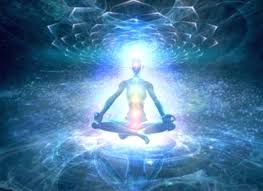 Human Divinity
Human Divinity
Alice Baily taught the human is divine and the Christ was much different than Christians believe and the Bible teaches. On man's divinity she said:
“We are all Gods, all the children of the One Father, as the latest of the Avatars, the Christ, has told us.”
In Theosophy and world-problems, Bailey stated:
“A vital contribution of the Theosophist to educate is… the assertion of the fundamental divinity of man, and of the gradual deification of man as the process of evolution. This fact, I venture to think, is of vital importance in education. The child is not only an age-old soul, but he is also, in essence, Divine, and he has the three great gifts of Divinity, of God to man, and of God to His creation—essential omnipotence, essential omniscience, and the time to make the essential real.
While making man divine she Denies Christ. She said he did not sacrifice for us:
“It must be remembered that it is the teaching given by the Christ which saves humanity – not any symbolic death upon a cross. Men must save themselves by their reaction and their response to the teaching given in its purity by the Christ.”
Nor is Christ’s Kingdom of this world. In The Externalisation of the Hierarchy she wrote:
“Christ taught also that the Kingdom of God is on Earth and told us to seek that Kingdom first and let all things go for its sake.”
The Bible teaches otherwise. Jesus Christ said to Pilate while He was on trial for His life: “My kingdom is not of this world” (Jn. 18:36).
Jesus did not ascend to heaven to sit at the right hand of the Father according to Baily. Rather, he remained on earth:
“He cannot return because He has always been here upon our Earth, watching over the spiritual destiny of humanity; He has never left us … He can only reappear,” coming forth from “His present retreat in Central Asia."
Maria Montessori's belief on divinity and the philosophy of Nature:
"The child unconscious drinks in divine power, whilst the reasoning consciousness of the adult is but human."
With this belief the offspring are designed to be more evolved than their parents, not through natural selection but mystical evolution. The whole process of teaching the child is going to be askew. and the role of the teacher entirely different from her traditional role. (More on that below.)
Move to Teacher section: This follows with her belief that the teacher "cannot have any immediate influence either upon the formation or upon the inner discipline of the students, and that her confidence must be placed and must rest in their hidden and latent energies.
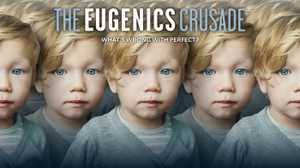 Eugenics
Eugenics
The purpose of man's reproductive ability is not to create the same being it is to create the next soul the higher soul in the chain of evolutionary development according to Theosophy. If we produce a lesser being we are therefore contrary to "natural law" then eugenics then becomes something that we ought to do and it is desired by God.
Alice Bailey supported eugenics, which became popular in the 20th century. Bailey said in her Unfinished Autobiography,
“certain physical restrictions should be imposed, because it is now evident that beyond a certain point the planet cannot support humanity...The emphasis in the future will shift from the urge to produce large families to that of producing quality and intelligence in the offspring. This will include that science of which eugenics is the distorted and exoteric indication.”
“The real change in human consciousness which is needed will appear only as the race itself is brought under a rhythmic law...thus transferring the whole concept on to a higher turn of the evolutionary spiral.”
Francis Galton, British explorer and natural scientist and a cousin of Charles Darwin, coined the term eugenics in 1883. He perceived it as a moral philosophy to improve humanity by encouraging the ablest and healthiest people to have more children. The goal of eugenics is to make the world a better place by guiding the course of human reproduction and “purifying” the gene pool. Eugenicists advocate genetic screening, birth control, abortion, racial segregation, euthanasia, compulsory sterilization, and forced pregnancies.
The Bible does not specifically mention eugenics, but the idea behind eugenics—that man can better himself by ridding the world of “undesirable” people—is definitely not biblical. Eugenics encourages mankind to seek and create their own utopia on earth, thereby abrogating the authority of God. We are given the command in Genesis to "Be fruitful an multiply" (Genesis 1:28). Jesus' example to the world was to help the afflicted. St. Paul said to the elders of the church, "In everything I did, I showed you that by this kind of hard work we must help the weak, remembering the words the Lord Jesus himself said: ‘It is more blessed to give than to receive’ ” (Acts 20:35).
Margaret Sanger, founder of Planned Parenthood was one of the leading advocates of the eugenics movement. She wrote in her book, When Should a Woman Avoid Having Children? that “No more children should be born when the parents, though healthy themselves, find that their children are physically or mentally defective” and, “By all means there should be no children when either mother or father suffers from such diseases as tuberculosis, gonorrhea, syphilis, cancer, epilepsy, insanity, drunkenness, and mental disorders.”
After Nazi Germany exposed the horror of the eugenics movement beginning in 1933 with a law mandating the forced sterilization of certain individuals with physical and mental disabilities, most forms of eugenics fell out of favor. Yet today certain forms are still widely accepted in America, such as aborting "defective" offspring such as those with Down syndrome.
Did Maria Montessori believe in eugenics? In her book, The Absorbent Mind published while she was in India, she wrote,
So according to the circumstances in which the cell finds itself, you can have a more beautiful individual or a less beautiful individual, a stronger individual or a weaker individual. And this is due to the combinations between the genes. The combinations are so many that every human being is different from every other...
Today much time is spent in studying what is the circumstances which will make the better characters come forth; a new science has arisen, Eugenics, which shows how man has by his intelligence succeeded in acquiring influence even over heredity. Human intelligence has understood that heredity can be influenced only at the stage when the primitive cell is formed and changes can be made. Thus man becomes a sort of god who takes in hand the powers of life and orients the path it will take...
Nothing much has been done in this direction in the field of humanity, but in that of plants and animals, man has been able to influence heredity to a great extent. What does it mean when one has the power of life in one's hand? It means that we can dispose of heredity so as to transform the species. This is the fascinating part that in our days focuses on this science the interest of hundreds upon hundreds of people. Today this interest is not academic or philosophical. Today it has invaded the practical field. Great numbers of plants and animals have been transformed...
Man has captured a secret of life. He has become a sort of magician who has embellished life with the magic wand of his intelligence; because of it, the world is much richer and more pleasant. We begin to see one of the aims of the life of man, one of the reasons which makes him one of the great cosmic forces. He has not been placed in the world in order to enjoy beautiful things. He has been placed here to make the world better. Man has intelligence because he has to make a better world than that which he has found. It is as though man were the continuator of the creation, as though he had been sent to employ his intelligence in order to help and make creation more perfect.
Can we really make a "more perfect" creation than God? Maria Montessori believed we could.
 The Role of a Teacher
The Role of a Teacher
Annie Besant promoted that the teacher is no longer teaching she is just a mere facilitator:
It is the work of the teacher to watch, not to control, not to give instruction, but to educate, to watch, to draw out that which already is there.
Maria Montessori maintains that the teacher is not there to pass on information, but merely to guide the child in his process of learning. From an article printed for Theosophy on the The Child she wrote:
The most difficult thing is to make the teacher understand that if the child is to progress she must eliminate herself and give up those prerogatives that hitherto were considered to be the sacred rights of the teacher. She must clearly understand that she cannot have any immediate influence either upon the formation or upon the inner discipline of the students, and that her confidence must be placed and must rest in their hidden and latent energies.
Montessori teachers are not supposed to give approval, give grades or make corrections; they are instead supposed to offer suggestions, encourage and redirect — merely guiding children through the materials, while the children make their own choices. The idea is that this way, a child will be able to feel successful without any praise or help. The teacher does not impart any teaching into a child since they already innately know. The brain is already filled with knowledge and you only have to draw it out.
Montessori on cosmic education of the child brought forth the concept that teachers need to show the children how all the things in the universe work together because it is somehow one organism and moving towards one perfection as stated above.
We use the term "cosmic education" to refer to an education which is an effective preparation of the new generations to understand how humanity is being drawn towards a unified whole. This concept must not be presented as some ideal imposed upon mankind in order to judge their actions, but as a pre-existent reality which is constantly unfolding. We are not talking about the forcing of human beings to cooperate with each other so as to be united. Rather, we are speaking about elevating human consciousness.
Montessori is in line with Teilhard's belief that as we evolve higher man's consciousness is changing. He is becoming unified with everything. He is becoming more conscious.
Pros of the Montessori system
- Children learn self-discipline and self-motivation.
- Hands-on learning is the main Montessori Method, replacing standardized tests, lectures, and memorization. Homework is a rarity, helping to develop a love for learning and discovery without incentives.
- Children are presented with a broader range of knowledge about the world around them.
- Each child learns at a different pace individual to their own development.
- Children learn “grace and courtesy” and neatness in the environment.
Cons the Montessori system
- Since the curriculum is very loose children can be under-prepared on certain subjects like math or over-prepared on others like art.
- For primary, ages 3 to 6, children do little to no “work” together. Everything is separated despite there being a lot of evidence supporting imaginary and group work. While some students may prevail in this system, many stagger behind.
- There is little to no support if you have a disability despite Montessori’s earliest work with children with disabilities.
- Individual learning is preferred while social interaction is discouraged, thereby there is little to no support for students socially. Children are either working alone with their work or in a circle group led by the teacher. Thereby, children don't learn how to interact together and develop community skills. Arguably preschool, more so than any other level, is the environment for the most formative social learning; kids are not only learning how to interact with others but understanding their place within a community.
- Individual freedom is encouraged while creativity is often curbed. If a child tries to invent new ways to use the works and does not do a work in the correct way they are usually told "we don't do it that way, we do it this way". This causes the child to have to self-correct because the activities can only be accomplished in one way.
- There is little room for improvisation and invention. Montessori does not value imaginative play like make-believe (like pretending to be a horse or a race driver). Given the known benefits of pretend play for children’s cognitive and social development, this loss can be detrimental to their whole beings.
- Students are taught to do “works” and they need to do it either at a table or on a work rug. If another student who doesn't fit into the system very well and wants to interact, they are told not to interrupt or go away. This causes inharmony and problems.
- Montessori fosters independence in children through age-appropriate "jobs" that are designed with conceptual learning blocks in mind. While children are supposed to figure out the materials themselves as it was "drawn" out of them, most children need and ask the teachers show them how to use the materials. Thus the child still needs to be taught regardless of the concept they innately know and just absorb or pull this knowledge out of themselves.
- The system does not work well after fourth grade. In subjects such as history, biology, reading comprehension, writing, you have to lecture and that is what Montessori teachers have done in later grades.
- Because of the high cost of the tools and tuition, this education is limited to the higher upper-class families, limiting its potential mainly to them.
- When children no longer have access to Montessori schools either because of personal circumstances or later grades aren't available, some children have a very difficult time moving from the Montessori classroom of self-guidance to a traditional classroom where you must conform to the rules and be taught by a teacher.
While Montessori herself advocated to treat children as whole beings, she left some important parts of their being, namely imagination, creativity, and social interaction. Maria Montessori also discouraged imagination in education and in its stead advocated a concretely reality-based learning; in particular this dismays many teachers who place storytelling and creative activities in the center of their classroom.
The following is a quote from the North American Montessori Teachers Association Journal. They claim that Montessori can bring world peace “A type of new man, a better humanity.”
-
“Maria Montessori, along with many other enlightened thinkers of our time, foresaw nothing less than the emergence of a new human culture. This new culture, a global, planetized humanity, would be based on a new consciousness of the unity and interdependence of all being, the interconnectedness of all forms of energy and matter. It is a culture of the present paradigm shift, by which we are beginning to align ourselves to educate the human potential for conscious cooperation with the evolution of life on the planet.”
Note the New Age terminology used in this statement about Montessori:
- “new human culture”
- “global planetized humanity”
- “new consciousness”
- "interconnectedness of all forms
- "paradigm shift”
- “evolution of life”
Teachers are encouraged by Montessori education to help the "divine" child who is above the "mere human" of the teacher to find their own place in the cosmos, and accept the doctrine of a Mother Earth which is God or Divine. Montessori's teaching methods, while having many benefits, are still embedded with New Age beliefs and Theosophy's false doctrine and fall under the error of modernism with concepts like children are 'little messiahs'.
Having the knowledge of Maria Montessori's philosophy and background is meant to help parents make an informed choice on whether they want to utilize this method for their children. It is obvious Maria Montessori had a love for children and a desire to help mankind. Still, we must consider that because this method provides benefits for many children that on the downside there is a price to pay in the many cons parents have observed as listed above.